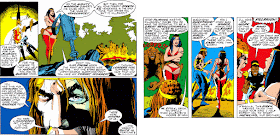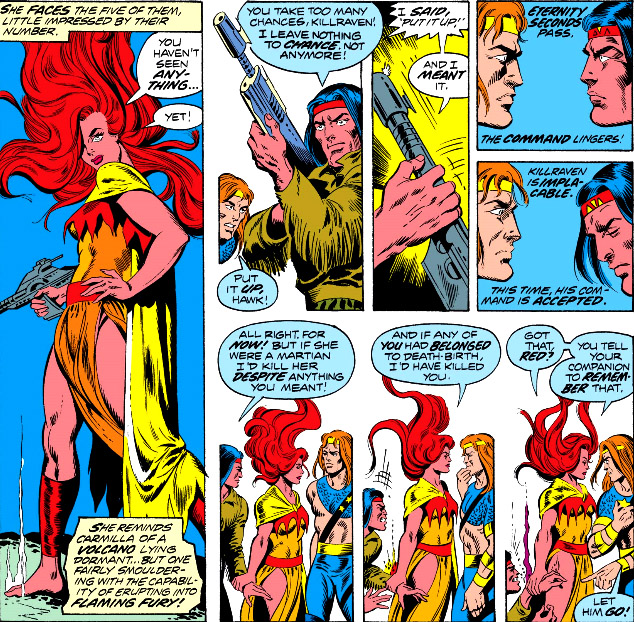Following up on a previous post that explored the launch issue of the Amazing Adventures series "War Of The Worlds" from 1973, it was evident that the acclaimed yet troubled series would be off to a shaky start, with its writer and artist moving on to other commitments soon after the book's second issue saw print--and only a semblance of direction for moving forward provided by its creator, Roy Thomas, the series now waiting for whoever would pick up its reins. After Marv Wolfman stepped in to script the third issue, the writing position, at least, was secured when Don McGregor joined the book for what would be the entirety of its run, while pulling double duty with the "Panther's Rage" storyline in Jungle Action.
But who to pencil and ink the series from this point? We know that artist Craig Russell would come aboard eventually (with the tenth issue) to add his talents to McGregor's and provide the series with the distinction it still carries to this day; in the meantime, the upside to the book's artistic direction being in flux is that readers were treated to a succession of different hands that brought their interpretations to the concept and the characters. That would be, in order of appearance, Herb Trimpe, Rich Buckler, and Gene Colan, with a number of inkers that included Frank Giacoia, Klaus Janson, and Frank Chiarmonte. Below are brief samplings of their contributions to WOTW, though you'll certainly want to enjoy their respective issues in their entirety.
Herb Trimpe
We've already seen Mr. Trimpe's debut splash page above--and as the artist who for all intents and purposes leads off this new series, his dynamic pencils seem made to order for bringing new readers to the book and treating them to action admidst the ruins left in the wake of the Martian invasion. As we can see, Killraven, the former gladiatorial slave who broke out of captivity and has become the de facto leader of his small band of Freemen, is handled well by the artist, while Trimpe shifts his look immediately to something more fitting for the character (perhaps at the behest of Wolfman, who scripts only one issue following Gerry Conway's departure); and if there's an artist who can do a Martian tripod justice, it would be someone whose depiction of military hardware in Incredible Hulk practically made it another character in the book.
Inks: Frank Giacoia
The final four panels are inked by artist Yolande Pijcke, in (to my knowledge) her only work for Marvel. Of the three artists who inked Trimpe's work on WOTW, I'd have to declare a preference for Giacoia, whose finishes typically allow the pencils to dominate--and having seen Trimpe often ink his own work, the combination of the two artists seems a perfect fit.
Inks: Frank Chiarmonte
We can see that Chiarmonte is adding a bit of his own style to that of Trimpe's; still, there's no denying the power of Trimpe's pencils, and the two do good work together in the pair of issues they produce.
Inks: Jack Abel
Abel inked a good deal of Trimpe's work in Incredible Hulk, and his style tends to soften Trimpe's to some extent. This would be the only issue he would ink with Trimpe, though he would step in again to work with Russell on a story.
Rich Buckler
Buckler, of course, was working with McGregor in Jungle Action to get "Panther's Rage" off to a start, while also doing some excellent work in Deathlok around the same time he was tapped to do an issue of WOTW. He pencils only one story; but throughout, you can almost see McGregor's method of storytelling changing from keeping pace with the more action-packed posture of Trimpe's style to something more introspective, becoming the foundation for McGregor's approach from this point on.
Inks: Klaus Janson
Is it me, or does it seem that Janson's work suits just about every artist he works with?
On an unrelated note, this issue was the subject of a disquieting notice in a later letters column that states that the issue marked the point where sales of the WOTW series took "a somewhat downward plunge." I don't know how you lessen the impact of the word "plunge," but obviously Marvel continually surprises in that regard.
Gene Colan
Like Buckler, Colan only pencilled a single issue of WOTW--but his early '70s work speaks for itself, and his contribution here was no exception.
Inks: Dan Adkins
Craig Russell
It's safe to say that Russell and McGregor were on the same page (so to speak) with WOTW and how its characters would mesh with the long road the series was taking, much more aligned now with Thomas's vision but moving at a slower pace that allowed its core characters to be more reflective as opposed to reactive. Whether that benefited the book was ultimately decided at the sales counter--but on the whole, Russell's work played a major part in setting the series apart from standard comics fare, while McGregor's narrative and characterization made an effort to keep the Martians in focus. When readers think back on WOTW, they likely think of McGregor and Russell, and with good reason.
Inks: Jack Abel
Inks (and Colors): Craig Russell
BONUS!
Over in the UK, it was becoming a problem for supply to keep up with demand regarding Marvel's 1974 Planet of the Apes weekly, which recycled material from the US Planet of the Apes magazine. But since the British effort was being published weekly, its recycled strips were quickly catching up with the originals, meaning that soon enough the weekly would have no product for its ravenous POTA readers. Doeg Moench, writer of the US version, explains:
"I used to get these calls like, 'Can you do a one-part Apes story?' and I’d ask when they needed it, and that would be that. I think England went Planet of the Apes crazy. Marvel UK started doing a weekly and they actually got ahead of us at one point. We couldn’t keep up with their weekly schedule. They asked me to do this original stuff for England that we later put in the American version. That later happened with 'Master of Kung-Fu' and 'Deadly Hands of Kung-Fu' as well. It didn’t last very long... and I couldn’t keep up with their weekly schedule."
And so more recycling was done, and from an unexpected source: Marvel UK continued the title by running the War of the Worlds stories from the American Amazing Adventures comic but changed the name of the main hero, Killraven, to "Apeslayer," while retouching the heads of all of his opponents to ape heads so that he was fighting apes instead of Martians. The UK version also benefited from a windfall of panels that had been edited out of the US version to save space.
Have a look at the synopsis (my own comments are added in brackets):
" 'The Masters' [the Martians], simian aliens from Mars, invaded Earth, enslaving a pocket of humanity still living in the ruins of Earth's cities. Human scientists, brainwashed to work for the simians, acted as a controlling force known as 'the Generals', while war machines known as drone tripods decimated the planet beyond its post-nuclear state. The Masters captured and brainwashed a scientist named Raker [the Keeper], making him a tyrannical General and placing him in charge of gathering human youths for gladiator training. Despite the aliens' control, Raker secretly plotted against them, searching for a youth with the potential to throw off the yoke of slavery and defeat the invaders permanently. General Raker ordered a boy named Jonathan Dozer [Jonathan Raven] to gladiator training.
"Over the next five years or so, Jonathan excelled in swordplay, karate, savate and wrestling under the tutelage of a cruel alien ape named Warlord. Besting all his opponents, he earned the name 'Apeslayer' [Killraven]. Eventually, he escaped the aliens, injuring Warlord, to Staten Island aboard a homemade raft. There, he met a resistance cell called the Freemen (including Mala [M'Shulla], Arrow [Hawk] and Socrates [Old Skull]). Apeslayer lived among the Freeman for the next six years, eventually becoming their leader." [Carmilla Frost is also recycled into "Sandra 'San' Simian." Words fail me.]
Apparently the "Apeslayer" storyline was less well-received than Marvel's other POTA product, finally fizzling out after

































I was a regular reader of the UK Planet Of The Apes weekly but I was completely unaware that Apeslayer had originally been Killraven and the apes had been Martians (never having heard of Killraven at the time). Amazingly, I remained unaware until about 15 years ago when I read about the Killraven/Apeslayer switcheroo in a magazine article.
ReplyDeleteBut I distinctly recall that I loathed the Apeslayer story and couldn't wait for it to end. Thankfully POTA #31 saw a return to normalcy with "Kingdom On An Island Of The Apes" which I loved, and #35 began the adaptation of "Beneath The Planet Of The Apes" which I was hugely looking forward to (and I saw the film around the same time).
Planet Of The Apes on the PPoC...yay!!
I can understand your frustration with the series, Colin. If I recall it correctly, the whole premise of "Apeslayer" seems a little hard to swallow, even for a POTA die-hard fan: bionic apes from Mars invading Earth. It removes the one compelling aspect of POTA--that simians evolved from Earth's past to take over the world, one indigenous species rising up against what had been the planet's dominant race and wiping out their civilization. What motivation did the Martian apes have for coming to Earth, apart from simple conquest? Equally ludicrous, it seems, is that we're really talking about Martian apes--what, there were no apes left on Earth that, let's say, became more intelligent as a result of mutation? They could have overwhelmed the Martians and taken over their equipment to suppress humanity. (And that's just off the top of my head.)
ReplyDelete